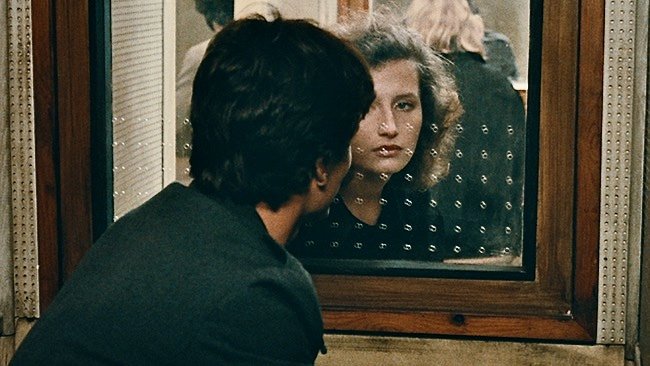Cinema’s Currency of Looks
The discourse of the screen. A philosophy of being.
From L’Argent by Robert Bresson. 1983. Cinematography Pasqualino De Santis, Emmanuel Machuel
Monter un film, c’est lier les personnes les unes aux autres et aux objets par les regards.
To set up a film is to bind persons to each other and to objects by looks.
Robert Bresson, Notes on the Cinematograph.
There are, it seems to me, not just the obvious one but three profound insights in this sentence from one of cinema’s greatest artists and thinkers.
The first, it goes without saying, can be found in the word looks. Obviously expressed perhaps, but with his brevity, the master’s simplicity encapsulates a wealth of cinematic understanding.
One of the most common faults in editing by new directors and editors, at least in my experience, is a tendency to cut on dialogue. A first character speaks. CUT. A second replies. CUT. The first responds. CUT. The second speaks CUT. Etc., etc….
As though when it comes to editing, it’s all about dialogue — a cinema that, as Hitchcock put it, consists of pictures of people talking.
Dialogue is one aspect only of human interlocution (even if its rich multifunctionality — and indeed disfunctionalities — rewards more plentiful consideration than is often given).
Silence is another. Perhaps more loaded than speech, deeper too. The eloquence in an absence.
So what is the vehicle of the silence?
The look.
Bresson continues thus:
The ejaculatory force of the eye.
The look as agency.
Looks connect (bind, he says) one character to another, to others, to things, places, to events, to thoughts even, to emotion.
What other properties of looks might there be?
Looks prompt fresh camera placement.
Looks prompt new angles.
A look up can motivate a high angle down, one down a low angle up.
Looks prompt changes in shot size.
Looks motivate camera movement.
Looks determine the direction of camera movement.
Looks inform the speed of camera movement.
Looks direct the eye path of the viewer over the screen — across the frame, up, down, left right, and across the cut.
Looks afford charge to one part of the screen over another.
Looks may prompt POV shots.
Looks may prompt cuts to wider shots of the looker, what they look at placed in foreground.
Looks can take the viewer into a character’s narrative POV…
Looks reveal thought, understanding, emotion.
Looks subvert/contradict words.
Looks reveal subtext.
Looks shift to tell a “micro-story”.
Looks downward suggest interior reflection.
Looks sideways suggest anxiety or thought/knowledge a character is hiding.
Looks reveal reaction.
Looks may determine the duration of the shot — between blinks. (See Walter Murch’s book.)
Looks motivate the cut.
Looks spark the transition from one scene to another.
Looks prompt score.
Looks emphasize a sound,
Looks engage the viewer.
Looks command the screen.
Looks seduce.
Looks accuse.
Looks defy.
Looks invite.
Looks acknowledge.
Looks define.
Looks celebrate.
Looks weep.
The look is the heart of the face.
Looks reveal the soul.
Looks form our primal language.
With Bresson, looks (as well as hands) render the performance of the actor — an art drawn from theatre — superfluous, even alien to cinema. Quite a heresy, given the embrace of Method and Meisner by actors and directors in much of American moviemaking. Quite a minimalism too…
And quite an austerity for those of us captivated and moved by the mysterious, magical, mischievous métier of the screen actor, their nuances of expression, stratagems of speech, intuition of the psyche, their exacting, precarious craft…
What else though, do the words of Bresson’s maxim say about the art of film? This leads to the second profound insight.
He uses the verb lier — to bind.
When a character looks to another, they are, in his mind, bound to them. The two are together and it is cinema that discovers this togetherness. This is a very different dynamic from that of a movie that reflects our (America’s) culture of adversarial individualism. In that context, a look may serve to separate. It can confront, oppose, and when weaponized kill — emotionally, viscerally, even, on occasions perhaps, literally. (Or else, it submits.)
Not a binding in our common humanity but a dividing in combat for power.
Drama is conflict, you might insist. But it can also be friction, tension — or as especially bright Chinese directing students of mine put it: a vibe.
What it is not, is harmony, or only for moments perhaps and often uncertain ones at that, maybe at a movie’s end (maybe not!). Bresson is not arguing for harmony though. In his vision, so it seems, we are bound to each other in this common humanity of ours — and what could be more dramatic than that with all of its contradictions, unresolved questions, failings, iniquities, puzzles, chasms, peaks, shadows, lights, despair and joy?
The third insight apparent in Bresson’s celebrated note relates to the look that binds characters to objects.
Not only are we bound together person to person but we are, each of us, bound inescapably to all forms in the world, the universe. Yes, even the individual, seen as a distinct, sovereign, solipsistic being in our western competitive culture, is in the understanding of Robert Bresson, inextricably bound to the simplest inanimate object.
For him, character and object exist together in a shared universe and it is cinema — transcendental as any art — that reveals that universe of mysterious togetherness.
Thus… Looks in Bresson’s and perhaps all cinema, we might reflect, reveal the nature of existence — of presence and the commonality of being.
Peter Markham
April 2024
